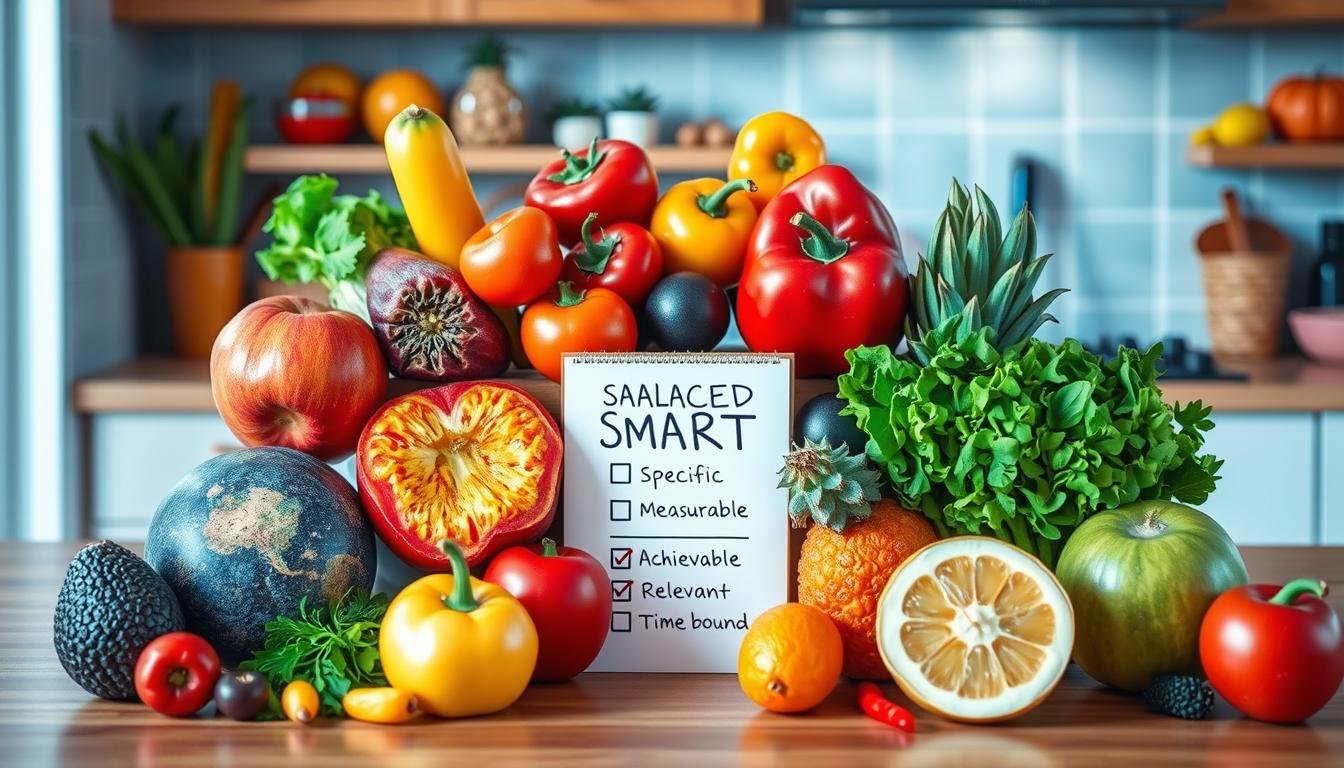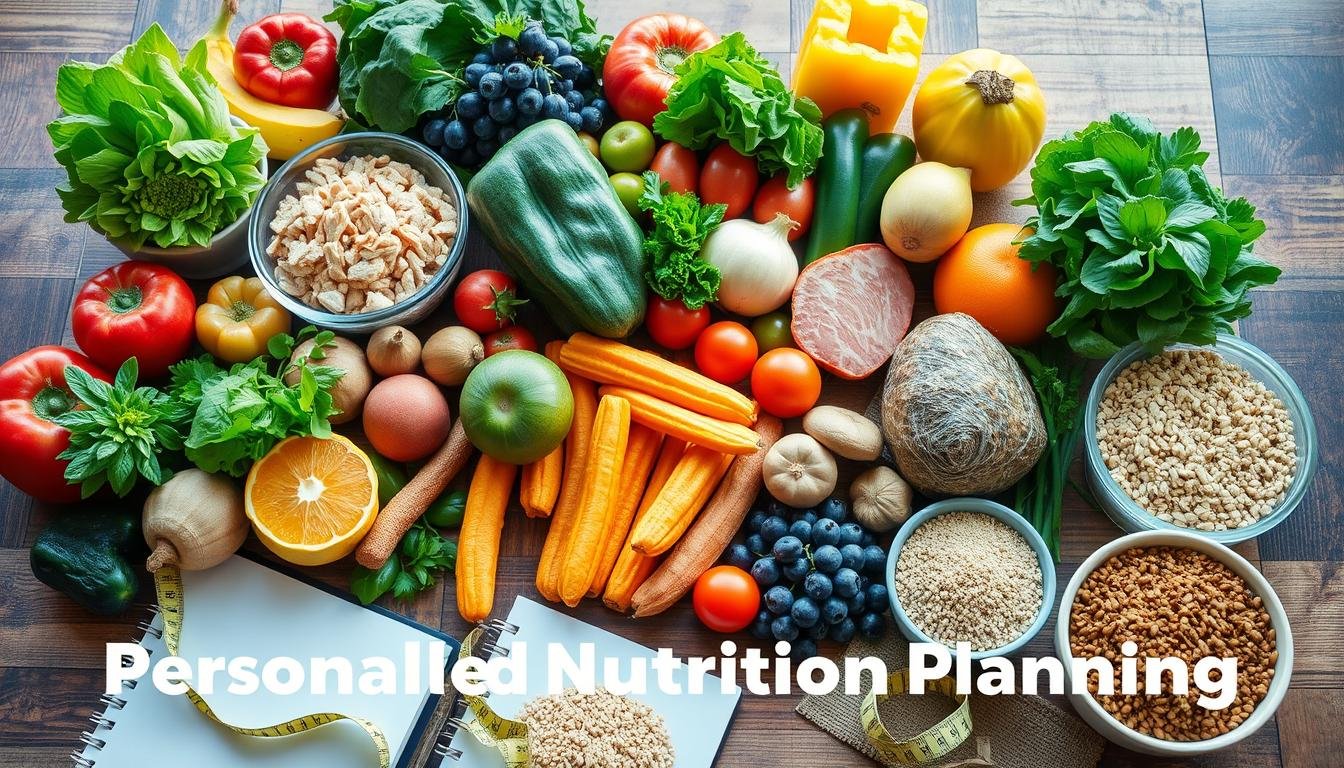Have you ever found yourself in front of the mirror, deciding to change for the better? It could have been at the start of a new year or a moment that made you think hard about your health. You promised to eat better, feel better, and live better. Yet, as time passed, your motivation started to dwindle.
Many people find it hard to keep up with their nutrition goals after the first month. Feeling overwhelmed is common, and excitement for change often fades. Even though many know what they need to do, putting it into action is a big challenge. But, it’s possible to overcome this.
Now is the time to stick to that promise you made to yourself. Smart nutrition goals can turn your dreams into reality. They make your aims clear, within reach, and positive. Whether you want to lose weight, get more energy, or be healthier, it all starts with setting the right goals and making steady steps.
Key Takeaways
- Setting SMART nutrition goals can dramatically increase your chances of success.
- It’s crucial to create goals that are specific, measurable, attainable, realistic, and time-bound.
- Breaking down large goals into smaller, achievable steps helps prevent feeling overwhelmed.
- Tracking your progress regularly can keep you motivated and committed.
- Reflecting on setbacks and making necessary adjustments ensures sustainable progress.
- Seeking professional help, when needed, can provide valuable guidance and support.
- Starting immediately without procrastination is essential for maintaining momentum.
Improving your eating habits shouldn’t be scary. Let this guide inspire and empower you to set achievable dietary goals. Start making better health choices through smart nutrition today.
Disclaimer: This article is for informational purposes only and should not be considered medical advice. Always consult with a healthcare professional before starting any new diet or health regimen, including the ketogenic diet. This post may contain affiliate links.
Understanding the Importance of SMART Goals

The Global Nutrition Report (GNR) tells us that SMART goals matter a lot for nutrition work. SMART stands for Specific, Measurable, Achievable, Relevant, Time-bound. This method helps leaders make good programs. They can see their progress and make sure they’re focusing on the right nutrition goals.
Specific
Being specific means you know exactly what you want. Let’s say you want to eat better. Instead of just saying “eat healthier,” you would say “I’ll have two servings of fruits and veggies each day.” It’s a clear goal.
Measurable
Measurable goals have numbers to show success. You might want to cut back on soda by 50%. Or maybe eat three servings of fruits each day. These goals let you check if you’re hitting your nutrition targets.
Read also:Boost Your Energy And Confidence With 8 Week Workout Plan
Attainable
Your goals need to be ones you can actually reach. Think about what you have and what you can do. Don’t set a goal so high that it makes you give up. Choose goals that push you but are still possible.
Realistic
A realistic goal fits with your life. Say you’re always busy at work. A good goal could be to prep meals on the weekend. This way, you know you’ll eat well during the week. It matches your lifestyle.
Time-bound
Having a deadline for your goal helps keep you on track. You might try to stick to your diet plan for three months. A set end date gives you a clear target and makes you more likely to stick with it.
To wrap it up, SMART goals help you get better at nutrition in a clear way. They make sure your goals are specific, measurable, attainable, realistic, and time-bound. Following this approach can make improving your diet feel less overwhelming. You’ll find it’s possible to reach your nutrition goals.
How to Set Realistic Healthy Eating Habits

Setting realistic healthy eating habits is key for lasting health. It means looking at what you currently eat, making small changes, and using tools like food journals. Ready to begin?
Identify Your Current Eating Habits
To eat healthier, first understand your diet. Ask yourself what and when you eat. It reveals where you can improve. Are you eating balanced meals? Do you frequently consume processed foods? These are important questions to ask.
Choosing Small and Achievable Steps
Begin with small, reachable goals to improve your eating. Even adding one fruit or veggie each day can make a big difference. It could lower disease risks by 12%. Consider these examples:
- Eating fruit at breakfast three times a week.
- Choosing dark chocolate and berries instead of cookies three days a week.
- Drinking a glass of water in the morning to increase your metabolism by 30%.
Starting with easy steps makes them easier to stick with. This leads to permanent change.
Using a Food Journal for Awareness
A food journal helps you keep track of your eating habits. Recording your meals shows patterns and triggers. Studies show that daily tracking helps 85% of people lose weight.
Apps can make food journaling simpler and more effective. They let you note your meals, nutrient levels, and diet quality. This boosts your success in meeting nutrition goals.
By following these steps, you’ll develop healthy eating habits that stick. Remember, progress towards being healthier should be steady and purposeful.
Creating a Personalized Diet Plan

Making a diet plan just for you is key for lasting nutrition and better health. It helps if you want to lose weight, deal with allergies, or just be healthier. A plan made just for you meets your needs well.
Nutritional coaching can create a diet that considers your food limits. With tools like ChatGPT, you get affordable, research-backed advice. This advice comes from trusted nutrition and fitness studies.
A diet made for you helps you eat a mix of all needed nutrients. This way, you’re more likely to stick to it because it’s designed for your health goals and likes.
| Benefit | Explanation |
|---|---|
| Cost-effectiveness | Using AI tools like ChatGPT provides an affordable alternative to hiring personal trainers or dietitians. |
| Customization | Personalized nutrition plans can be tailored based on individual input, making them highly relevant and effective. |
| Data-driven | ChatGPT’s advice is based on extensive and reputable data, ensuring scientific credibility. |
Checking your diet and exercise plans often is key to success. Talking to health pros and using food journals help you know your eating patterns and progress better. Adding personalized coaching can really improve your diet plan’s success.
Doing 150 minutes of moderate or 75 minutes of hard exercise a week is important. This, with eating right, is the base of a good nutrition plan. Choosing regular exercise over hard workouts helps make lasting healthy habits.
Effective Meal Planning Strategies

Meal planning is key for anyone wanting to eat healthy and reach their fitness goals. It leads to smarter food choices and a diet that’s right for you. This can help you stick to a balanced intake of nutrients.
Planning Nutritious Meals
When you plan meals, choose a mix of food that meets health guidelines and your goals. It’s important to make sure each meal has protein, grains, fruits, and veggies. This balance is crucial for a healthy lifestyle.
- Be Specific: Aim to include five various vegetables in your diet each week.
- Stay Measurable: Keep track of how many servings of fruits and veggies you eat daily.
- Keep It Attainable: Choosing seasonal fruits and veggies makes meal planning fun and flexible.
Grocery Shopping Tips
Smart grocery shopping is vital for following your meal plan. Here’s how to shop wisely:
- Make a shopping list that matches your meal plan to avoid buying on impulse.
- Pick whole, unprocessed ingredients for nutrient-packed meals.
- Shop around the store edges. That’s where the fresh stuff is.
Meal Prep Best Practices
Good meal prep is a savior for a healthy diet, saving you time and stress. Here are tips to do it right:
- Prep your meals beforehand to stay away from junk food on busy days.
- Use quality containers to keep meals fresh for longer.
- Cook large batches of grains and proteins to use in various meals through the week.
- Add different textures and colors to your meals to keep them interesting and tasty.
| Meal Plan Component | Traditional Option | Healthier Option |
|---|---|---|
| Breakfast | Traditional diner breakfast (700 calories) | Healthier breakfast (400 calories) |
| Lunch | Restaurant burrito (1,000 calories) | Home-made burrito (750 calories) |
| Dinner | Meal with less variety (1,500 calories) | Meal with more variety (700 calories) |
| Dietary Guideline Plate | High processed grains, few vegetables | Less processed grains, variety fruits & vegetables |
Tracking Your Progress
Understanding what improves your health is important. Apps and tools offer helpful feedback quickly. They help make tracking your nutrition easier.
Using Apps and Tools
Many apps today can track what you eat and how much you move. MyFitnessPal, Lose It!, and Fitbit are some popular ones. They give feedback on your eating habits and exercise. Plus, they have useful features like barcode scanners and meal reminders.
- MyFitnessPal: Offers a comprehensive database of foods and an easy-to-use interface.
- Lose It!: Focuses on calorie counting and goal setting.
- Fitbit: Integrates fitness tracking and dietary monitoring.
With these tools, you can understand your habits better. They help you keep your eyes on your goals, like losing weight or getting stronger.
Benefits of Regular Monitoring
Checking on your progress regularly has many benefits. Here are some important ones:
- Staying Motivated: Seeing your progress keeps you going.
- Identifying Strengths and Weaknesses: It’s easier to see what helps you and what doesn’t.
- Informed Decision Making: You can make better choices with real data.
By tracking your food and grocery buys weekly, you learn more about your choices. Meals with fruits, veggies, protein, and grains are better planned this way.
| Tracking Method | Pros | Cons |
|---|---|---|
| App-Based Tracking | Easy to use, real-time data, comprehensive food databases | Requires smartphone, potential data privacy concerns |
| Food Journal | Increases awareness, personalized tracking | Time-consuming, can be less accurate |
| Visual Plate Method | Easy to understand, emphasizes balanced meals | Less detailed, may not track all nutrients |
Using a mix of these methods gives a full picture of your nutrition. They help you stay focussed on your health goals.
Incorporating Mindful Eating Practices
Mindful eating means paying full attention to your food. From shopping to eating, be mindful. It lets you enjoy your meals more and understand your body better. This helps prevent eating too much and improves digestion. Mindful eating is key for managing weight and mental health.
Stress can lead to overeating and obesity. Mindful eating helps combat this by fostering a healthier food relationship. It lessens emotional and binge eating. Thus, it’s effective against unhealthy eating habits.
A review of 10 studies found mindful eating as good as traditional diets for losing weight. Habits like chewing well and avoiding distractions while eating promote better eating patterns and weight control. A 12-week mindful eating course helped women lose an average of 4 pounds.
Mindfulness therapy also helps people with binge eating and bulimia nervosa control their eating better. So, mindful eating is great for those who struggle with regular diets.
Only 5% of diets work well without expert advice. Yet, when people set clear nutrition goals, 90% find them achievable. This shows how mindful eating links to reaching health goals.
To make mindful eating your own, start with these steps:
- Eliminate distractions during meals.
- Chew thoroughly and enjoy each bite.
- Pay attention to when you’re hungry or full.
- Think about how eating makes you feel.
This way, your eating habits will support your health goals, making success more reachable and gratifying.
Conclusion
Setting SMART goals means more than changing what we eat. It’s about a complete health overhaul. These goals should be specific, measurable, attainable, realistic, and time-bound. This way, we’re more likely to achieve lasting weight loss and feel better overall.
Making good choices about our meals and eating mindfully is key. It’s all part of this health-changing adventure.
Understanding how weight management works is important. For example, putting on 1 kg needs about 7500 kcal extra. That means eating 250 kcal more daily to gain 1 kg in a month. To lose weight in a healthy way, cutting our daily calories by 500-750 kcal works well. Specific goals are crucial for sticking to our plan, say Pearson et al. (2017).
Keeping track of our progress is a must, according to Wing & Phelan (2005). It helps us stay on course and see when we need to tweak our nutrition. By staying committed, planning well, and choosing healthily, we can enjoy great health benefits.
Burke et al. (2011) say setting reachable goals is the foundation of lasting motivation. It also helps us stick to weight management programs successfully.
Disclaimer: This article is intended to provide helpful recipes and ideas for your enjoyment and convenience. However, it is for informational purposes only and should not be considered a substitute for professional medical advice. Always consult a qualified healthcare provider before making any changes to your diet, lifestyle, or health routines. Please note that this post may contain affiliate links, meaning we may earn a small commission at no additional cost to you if you make a purchase through these links.






